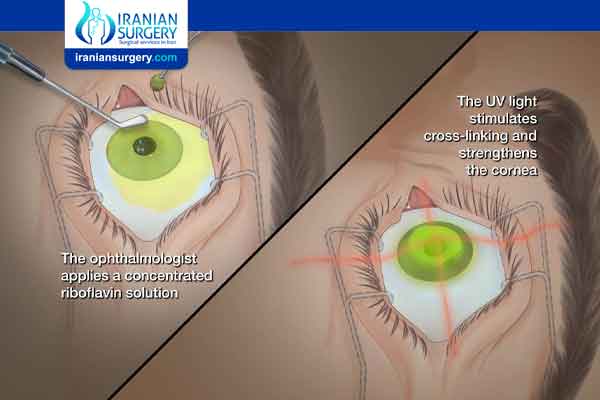What is corneal cross-linking?

What is corneal cross-linking?
Keratoconus risk factors
Is cross linking worth it?
How long does it take to recover from corneal cross linking?
Corneal cross-linking is a treatment for an eye problem called keratoconus.
In this condition, the front part of your eye, called the cornea, thins out and gets weaker over time. This makes it bulge into a cone shape, which can distort your vision and make it hard to see. If the symptoms of keratoconus get severe, you will need a corneal transplant.
In corneal cross-linking, doctors use eyedrop medication and ultraviolet (UV) light from a special machine to make the tissues in your cornea stronger. The goal is to keep the cornea from bulging more.
It’s called “cross-linking” because it adds bonds between the collagen fibers in your eye. They work like support beams to help the cornea stay stable.
Read more about: Corneal transplant recovery
Corneal cross-linking is the only treatment that can stop progressive keratoconus from getting worse. And it may help you avoid a corneal transplant, which is major surgery.
Signs and symptoms of keratoconus may change as the disease progresses. They include:
- Blurred or distorted vision
- Increased sensitivity to bright light and glare, which can cause problems with night driving
- A need for frequent changes in eyeglass prescriptions
- Sudden worsening or clouding of vision
No one knows what causes keratoconus, although genetic and environmental factors are thought to be involved. Around 1 in 10 people with keratoconus also have a parent with the condition.
Read more about: Lasik eye surgery
Keratoconus risk factors
- These factors can increase your chances of developing keratoconus:
- Having a family history of keratoconus
- Rubbing your eyes vigorously
- Having certain conditions, such as retinitis pigmentosa, Down syndrome, Ehlers-Danlos syndrome, hay fever and asthma
Does collagen cross linking improve vision?
corneal collagen cross-linking – an advanced procedure approved by the U.S. Food and Drug Administration (FDA) in 2016 – can vastly improve vision in patients of all ages. Corneal collagen cross-linking (CXL) is not a cure for keratoconus, but it can help prevent the condition from getting worse. CXL is intended to prevent steepening or progression of the keratoconus process to potentially avoid needing a corneal transplant.
Read more about: Keratoconus
Is cross linking worth it?
Before you check benefits and make surgical plans, it's best to ensure that the surgery has a reasonable chance of helping you to feel better. Current research suggests that this is an exceptional solution for people with keratoconus.
In one study published in 2017, researchers split people into two groups. One set had keratoconus and got no treatment. The other got epi-off cross-linking. At the end of the study, 86.7 percent of people had improved keratoconus after surgery, while only 26.7 percent of people with no surgery got better.
It's important to note that surgeons don’t promise that you'll have better vision after surgery. Instead, they tell you that your eyes will not continue to change shape. Even so, some studies suggest that people really do see better after cross-linking.
In a 2014 study, researchers found that about half of people who had cross-linking had an improvement of one line in visual acuity two years after surgery. These people probably still needed glasses, but their prescriptions were smaller.
Studies like this demonstrate just how powerful this treatment can be for people with keratoconus.
How long does it take to recover from corneal cross linking?
The treated eye is usually painful for 3 to 5 days; however, levels of discomfort vary from patient to patient. Recovery time is about one week although most patients may find that it may be slightly longer.
After treatment expect to take up to one week off work and for some patients who experience complications this could be longer. You will not be able to drive for at least a week. After treatment this may be severe. It is important to rest as much as possible during these days to let the eye heal. If you partake in activities or sport, please ask your doctor when these may be resumed.
Read more about: Treatment of Corneal Opacity
How effective is corneal cross linking?
Corneal Crosslinking was found effective in causing regression or halting the progression of disease in patients with progressive Keratoconus at three months follow-up, however, the efficacy of corneal crosslinking was unaffected by patient’s age and gender.
Read more about: Type of Corneal opacity
Can you see after corneal cross linking?
After a cross-linking procedure, your eyesight will be blurry at first. You may notice changes in your vision from time to time to time during the healing process. You may be more sensitive to light and have poorer vision for about 1-3 months after the surgery.
The goal of corneal cross-linking is to slow your disease and prevent future vision problems, but in some cases, your eyesight may get better over time.
Once you’ve had corneal cross-linking, you might need new glasses or contacts.
Read more about: corneal collagen cross linking procedure
How long does corneal cross linking last?
Based on corneal cross-linking study results over more than a decade, the beneficial effects of corneal cross-linking appear to last for many years and there is evidence that this strengthening effect may be permanent. This is mainly related to how old the patients were when they first underwent cross-linking. In simple terms, the younger the patient is at the first cross-linking, the higher the likelihood that they will need a second treatment after 7−8 years.
The cornea is completely rebuilt every 7−8 years – a fact that has only recently come to light. What this means is that no original cross-links are left after this time. If the patients were still very young at the time of the first cross-linking, they are still young enough after 7−8 years for keratoconus to re-emerge.
Read more about: How long does a corneal transplant last?

